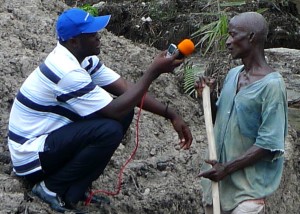Top 5 mistakes recording audio
 Many journalists don’t record audio as well as they should. Be it in radio or video production, recording good sound can make or break your story.
Many journalists don’t record audio as well as they should. Be it in radio or video production, recording good sound can make or break your story.
Below you can hear examples of some of the most common mistakes journalists make when recording audio. Once you’ve heard how these mistakes sound on tape, it should be easier to avoid them yourself.
The best tip for avoiding problems when recording audio is to always listen to your recordings as you do them with headphones. Good headphones while recording are a must!
Remember recording great audio takes practice. Get to know your equipment. Play around with it until you are sure of what you are doing.
1 Levels too high
Most professional equipment lets you adjust the recording level depending on how loud a sound is. This is great because it allows more control, but it means the journalist has to stay constantly aware. Listen below to an example of a recording where the levels were set too high. You can hear the distortion.
2 Levels too low
This is the opposite problem to the one above. Here the recording levels are set too low. When this happens the levels have to be boosted in post production. This causes a lot of background hiss.
3 Subject is “off mic”
If you don’t point your microphone towards your subject, you’ll end up with recordings which lack definition and clarity. To use your microphone properly you need to know its recording pattern, i.e. you need to know exactly in which direction to hold the microphone. On some equipment with built-in microphones this isn’t obvious, so check the manual.
4 Irritating background noise
This one is pretty self explanatory. Sometimes you want to keep background sounds to make your clip sound more lively or place the interview at a certain location. At other times, however, the background sound is just distracting. Background noise can be many things – other people talking, a busy street, a fan or an air-conditioner.
5 Recording in a room with echo
Very empty rooms – without furniture or carpet – will produce echo when people talk. This not only sounds terrible on tape, it also makes it difficult to cut out clips when you are editing. Reducing echo on-site can be tricky. If you’re doing an interview, try to move. A small room with more furniture, carpet, curtains or even books usually helps. If that doesn’t work, you can try to take your interviewee to a suitable spot outside.
There are plenty of other things that can go wrong when recording audio – hand movement on the microphone, wind noise, popping “p”s or recording the interference from mobile phone signals. The more you record, the better you’ll become at avoiding any problems.
Written by Martin Vogl



